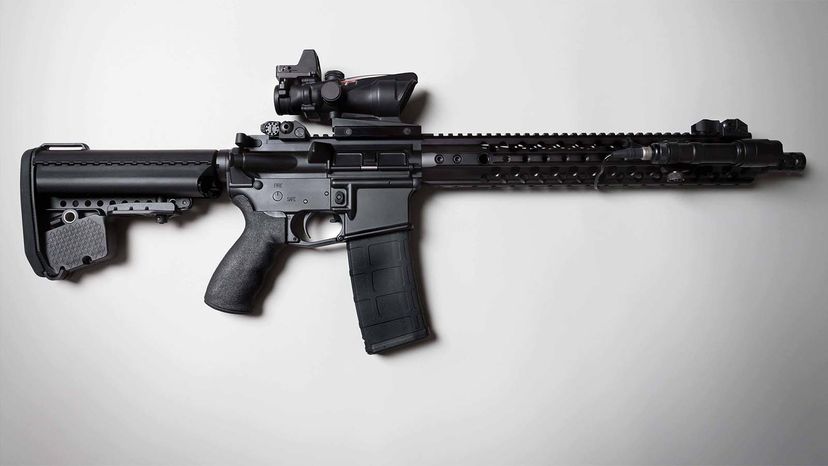
Key Takeaways
- The AR-15, initially designed for combat, has evolved into one of the most controversial firearms in the U.S., used in both military and civilian contexts, including mass shootings.T
- he rifle's history begins with the AR-10, which Eugene Stoner designed; the AR-15 was a lighter, smaller caliber version the U.S. military adopted as the M-16.
- In the civilian market, the AR-15 has become popular for its versatility, accuracy, and customizable features, leading to a significant increase in ownership, particularly amid fears of potential assault weapon bans.
The AR-15 rifle is, without a doubt, one of the more prolific and controversial firearms in U.S. history. It's been used in wars abroad and policing at home, and for everything from sport shooting to mass shootings. The NRA even calls the weapon "America's Rifle." But how did it come to be, and what was its original purpose?
Its history begins with the M-1 rifle. Designed by French-Canadian gun designer John Garand for the Springfield Armory in the mid-1930s, the M-1 rifle, universally referred to as the "Garand" rifle, was the chief battle rifle of GIs as they pushed the Axis powers from conquered Europe and North Africa and across the Pacific. Throughout its lifetime of military service it would inevitably see action in conflicts from World War II to modern day. The Garand rifle is still in use by ceremonial units within the U.S. military, particularly the U.S. Marine Corps Silent Drill Platoon.
Advertisement
But by the end of the Korean War it was beginning to show its age as a combat rifle compared to Mikhail Kalashnikov's AK-47 automatic rifle and other magazine-fed weapons. Once the Korean War ended, the U.S. Army began testing three replacements for the Garand — the Springfield Armory T44E4 and T44E5, which were updated versions of the Garand; the FN-FAL rifle from Fabrique Nationale of Belgium; and the AR-10 from ArmaLite, a division of the Fairchild Engine and Aviation Corporation.
The AR-10, was designed by Eugene Stoner, a former U.S. Marine aviation ordnanceman, and a machinist and design engineer at the Whittaker aviation equipment company. The AR-10 (the "AR" stands for "ArmaLite") was a magazine-fed, gas-operated rifle that fired a 7.62 mm bullet. It was made from aircraft-grade aluminum and, according to the ArmaLite website, weighed 7 pounds (around 3.2 kilograms), lighter than both the Garand and the AK-47. Inevitably, the U.S. military adopted the Springfield T44 rifle, which would become the M-14 — essentially an updated version of the Garand.
The future of the rifle would inevitably fall to the U.S. Air Force. According to an article in Gun Digest, in the summer of 1960 U.S. Air Force Gen. Curtis LeMay sought to replace the M-2 carbine used by Air Force security personnel with the AR-15, a redesign of the AR-10. The following year, an official at the Defense Advanced Research Projects Agency (known as DARPA) sent a handful of AR-15 rifles to U.S. Army Special Forces soldiers fighting in South Vietnam. The reviews from the field came back almost immediately — the GIs loved it.
"It was very, very efficient," says Mark Westrom, a former U.S. Army ordnance officer. He was also the owner of ArmaLite from 1994 until 2016.
For the next fifteen months the U.S. Army, principally U.S. Army Chief of Staff Gen. Maxwell Taylor, and Gen. Curtis LeMay of the U.S. Air Force would essentially compete for the soul of their favored rifles. Inevitably, Secretary of Defense Robert McNamara ordered the adoption of the AR-15 and by the end of 1963 the Army ordered roughly 85,000 AR-15 (now designated the XM16E1, or "M-16"), according to James Fellows in The Atlantic, and the U.S. Air Force ordered an additional 19,000. The M-16 had officially become the U.S. military's standard battle rifle.
A few years after the AR-15 was adopted by the military, Colt released a semi-automatic-only AR-15 rifle for commercial purchase. The rifle, with various upgrades and iterations, persists as the standard rifle of the U.S. military and is built and sold by countless gun manufacturers. The number of AR-15s currently owned by American citizens is veritably unknowable, namely due to laws preventing government agencies, such as the Bureau of Alcohol, Tobacco, Firearms, and Explosives from tracking firearms statistics. After the end of the Federal Assault Weapons Ban in 2004, which had only increased demand, sales of the AR-15 and its variants skyrocketed. Firearms enthusiasts find the AR-15 a highly versatile weapon — accurate, customizable, and easy to use. Owners can tailor the rifle to their specific needs and desires — different barrel lengths, stocks, magazine capacity, gun sites and targeting optics, flashlights, slings, and even color. Some hobbyists have used it as a canvas for artwork. Its customizability, in fact, has earned the rifle the nickname “Adult Legos.”
"It attracted a lot of attention and a lot of people wanted them," says Westrom. "Once military production slowed down [manufacturers] made commercial versions. It's kind of an exotic look, it's light recoiling, it's very, very accurate. They're interesting. They're more flexible than an M-14."
According to an economic impact fact sheet released by the National Shooting Sports Foundation, 1.3 million "modern sporting rifles," the term used by the NSSF to describe AR-style firearms, are produced yearly. As of 2016 they estimate there are somewhere between 5 and 10 million AR-15 rifles owned by an American citizenry with roughly 300 million total guns.
Advertisement
